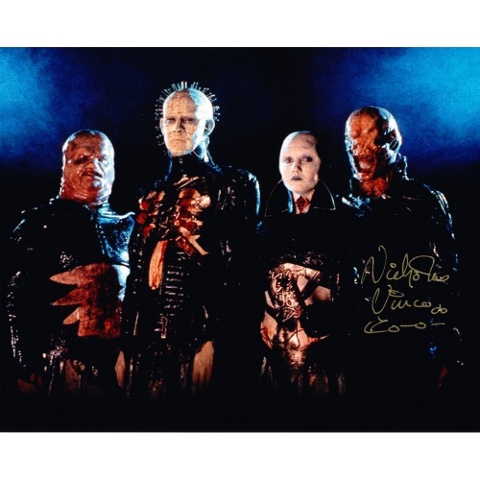i've come for my father
There is at least the one female Cenobite. So, we could assume there's some civil war kind of split in among the denizens of hell, and Julia serves Leviathan and brings him Channard to be his body, in which case the homicidal joy in the last act of this film is not on Channard as much but on Leviathan. Structurally, Channard does serve as a sort of pseudo-Christ-Figure--and, not I'm not about to get into some Cinematic-Christ-Figuring; don't need to. The guy willingly sacrifices himself, quite literally gets himself some stigmata, and has a giant penis attach itself to his head...
Wait, that last one is not part of the Cinematic Christ-Figure.
But, that penis is important to this third discussion of Hellbound: Hellraiser II because--
Actually, I've got to interrupt this entry because Kirsty was just telling Detective Bronson about fairy tales, and rather than thinking she's got no reason to connect the events of the first film to any fairy tale but just says that because of Julia's later bit about not only being the wicked stepmother but also the evil queen--
(It occurs to me that if Julia was just the wicked stepmother, then that fairy tale would be Cinderella, which makes the Cenobites... people at the ball and Pinhead in particular the Prince. Kirsty's glass slipper is her sanity, I suppose, since they throw her into a mental hospital... Ooh, or are the Cenobites the stepsisters who, in the Grimm version, cut off parts of their own feet out of a society-fueled obsession with finding love?)
--and her specific reference to Kirsty as Snow White--
(Which makes the Cenobites the dwarfs?)
--this time I thought less about the stepmother reference and just went with the fairy tale reference, generally, in my head. And, I thought of Little Red Riding Hood. The house in the original film was Kirsty's grandmother's house. She found there a wolf (her Uncle Frank) in, well, not her grandmother's clothing (skin) but her father's, which turns that particular fairy tale into less of a coming-of-age, men-are-dangerous-so-keep-your-legs-together story and something... else. The original Hellraiser becomes, then, a twist on Little Red Riding Hood with an evil stepmother injected into the mix. The Cenobites are just extras.
But, then we come to Hellbound and Kirsty's father is dead, her evil stepmother is (after some machinations) still around. There are no evil stepsisters, though there is one (sort of) stepsister in Tiffany, except I think she fills a different role, which I will get to below. The Cenobites are a dark version of the fairy godmothers from Sleeping Beauty, or a Catholic S&M version of the seven dwarfs from Snow White or, from Cinderella, Gus and Ralph and the other mice (Rita and Larry?) (not that those mice are canon beyond Disney's version). Leviathan/Channard is like the dragon to Julia's Maleficent (putting aside the fact that Maleficent was the dragon). It all gets a little convoluted.
But, it does bring us back around to where I wanted to go with today's entry. See, what Snow White and Cinderella have in common--that stepmother--is what matters here. Kirsty is not a child--Ashley Laurence was 20 when they filmed the first movie, and her character has just gotten herself a "room"--
(a Britishism that made it into a film that claims to be set in America)
--in which to live. These two films together are Kirsty's coming-of-age story. Her biological mother is already gone and (given Kirsty's reaction to her photo in this film) presumably dead. Kirsty's father dies, much like in Snow White or Cinderella, leaving her with the evil stepmother (and pervy Uncle Frank). In Cinematic Freudian terms, Kirsty cannot grow up until there are no parents in her way. And, grow up, she does, literally putting on her stepmother's skin to pretend to be her, interacting with this new (potential) father-figure--Leviathan/Channard. Then, in the end, she leaves with her surrogate daughter/sister Tiffany. (Note: Imogen Boorman is only 5 years younger than Ashley Laurence but Laurence is only 10 years younger than Clare Higgins. In Hollywood (even its British counterpart), actual age is irrelevant.) Tiffany's mom has been taken from her. Kirsty is there to save her (and vice versa).
Or are they just sexual awakening in human form? All the pain and pleasure of relationships, emotional and physical. All the blood, like the red of that riding hood, as a marker of female sexuality.
(An aside: right before Julia loses her skin again, she stands in the hallway with her hands on either wall, both a) moving like the Engineer from the original (who was supposed to make an appearance in this film, but got cut) and b) putting herself in the cruciform pose of the Christ-Figure.)
Thinking as I go, I wonder if the Cenobites make sense, metaphorically, as puberty or menstruation. They are turned back to human and Kirsty must play the part of the mother to trick Leviathan/Channard, who has replaced all her parents. Imagine the chaos of the labyrinth, the pain of what the Cenobites can do--that's all Kirsty going through puberty or PMSing, as it were. Then, she gets her shit together (and reject Leviathan/Channard's advances) and turns back to normal. Not particularly feminist, in this light.
Unless we take Tiffany as an aspect of Kirsty, the control she takes over her own situation.
So much of all this symbolism gets to be a bit on-the-nose, and a little disgusting, in Channard's death scene. He loses his head (literally) after getting stuck between Tiffany's legs (literally), and his decapitated body ejaculates blood (or some dark bodily fluid, anyway) as that giant penis thing moves on, as both Tiffany and Kirsty are now grown up enough to escape the labyrinth. Both marked with blood, now.

Comments
Post a Comment